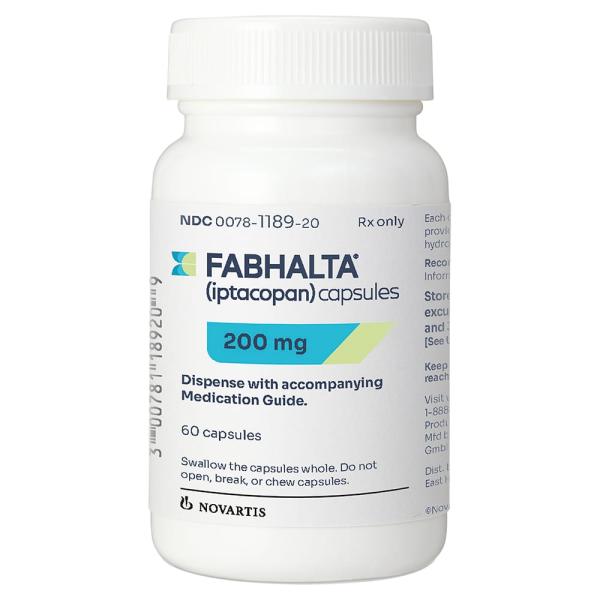Fabhalta Side Effects
Generic name: iptacopan
Medically reviewed by Drugs.com. Last updated on Sep 10, 2025.
Note: This document provides detailed information about Fabhalta Side Effects associated with iptacopan. Some dosage forms listed on this page may not apply specifically to the brand name Fabhalta.
Applies to iptacopan: oral capsules.
Important warnings
This medicine can cause some serious health issues
Side effects include:
Most common adverse effects (≥10%) in PNH: headache, nasopharyngitis, diarrhea, abdominal pain, bacterial infection, viral infection, nausea, rash.
Most common adverse effects (≥5%) in IgAN: upper respiratory tract infection, lipid disorder, abdominal pain.
Most common adverse effects (≥10%) in C3G: nasopharyngitis and viral infections.
See also:
For healthcare professionals
Applies to iptacopan: oral capsule.
General adverse events
The most common adverse reactions included headache, nasopharyngitis, diarrhea, abdominal pain, bacterial infection, viral infection, nausea, rash, upper respiratory tract infection, and lipid disorder.[Ref]
Cardiovascular
- Common (1% to 10%): Systemic hypertension
- Frequency not reported: Increased blood pressure
In 2 studies, increases in blood pressure (particularly diastolic blood pressure) were observed, with mean increases of 4.4 and 3.4 mmHg, respectively, at month 6; mean diastolic blood pressure did not exceed 80 mmHg.
Dermatologic
- Common (1% to 10%): Rash, urticaria
Rash included allergic dermatitis, acne, erythema multiforme, maculopapular rash, and erythematous rash.
Gastrointestinal
- Very common (10% or more): Abdominal pain (up to 15%), diarrhea (up to 15%)
- Common (1% to 10%): Nausea
Abdominal pain included abdominal pain, upper abdominal pain, and abdominal tenderness.
Genitourinary
- Common (1% to 10%): Urinary tract infection
Hematologic
- Very common (10% or more): Thrombocytopenia (up to 43%)
- Common (1% to 10%): Decreased platelet count
Decreased platelet count included thrombocytopenia and decreased platelet count.
Of 37 patients who had normal platelet counts at baseline, 43% experienced thrombocytopenia (any grade) during the study.
Metabolic
- Very common (10% or more): Hypercholesterolemia (up to 43%)
- Common (1% to 10%): Lipid disorder
Lipid disorder included dyslipidemia, increased blood cholesterol, increased low-density lipoprotein, hypercholesterolemia, increased blood triglycerides, and hyperlipidemia.
In 2 studies, 54 and 34 patients had normal total cholesterol levels at baseline; 43% and 24%, respectively, developed grade 1 hypercholesterolemia.
Musculoskeletal
- Common (1% to 10%): Arthralgia
Nervous system
- Very common (10% or more): Headache (up to 28%)
- Common (1% to 10%): Dizziness
Other
- Very common (10% or more): Increased serum triglyceride (up to 27%), viral infection (up to 18%), increased low-density lipoprotein (LDL) cholesterol (up to 17%), bacterial infection (up to 11%)
- Frequency not reported: Increased total cholesterol
Viral infection included COVID-19, herpes zoster, oral herpes, nasal herpes, positive influenza A virus test, and influenza.
Bacterial infection included pyelonephritis, urinary tract infection, bacterial bronchitis, Haemophilus bronchitis, cholecystitis, folliculitis, cellulitis, bacterial arthritis, sepsis, Klebsiella infection, staphylococcal infection, Pseudomonas infection, hordeolum, and bacterial pneumonia.
In 2 studies, 37 and 52 patients had normal triglyceride levels at baseline; 27% and 23%, respectively, developed grade 1 elevated triglycerides.
During 1 study, 60 patients had LDL cholesterol up to 130 mg/dL at baseline; LDL cholesterol increased to greater than 130 to 160 mg/dL, greater than 160 to 190 mg/dL, and greater than 190 mg/dL in 17%, 8%, and 7% of patients, respectively. In another study, 36 patients had LDL cholesterol up to 130 mg/dL at baseline; LDL cholesterol increased to greater than 130 to 160 mg/dL and greater than 160 to 190 mg/dL in 11% and 3% of patients, respectively.
In 2 studies, mean increases from baseline of about 37 mg/dL (0.952 mmol/L) and 17 mg/dL (0.433 mmol/L), respectively, were seen at month 6 for total cholesterol, and 32 mg/dL (0.83 mmol/L) and 18 mg/dL (0.467 mmol/L), respectively, for LDL cholesterol; mean values remained within the normal ranges.
Renal
- Frequency not reported: Pyelonephritis
Respiratory
- Very common (10% or more): Upper respiratory tract infection (up to 19.4%), nasopharyngitis (up to 16%)
- Common (1% to 10%): Bronchitis
- Frequency not reported: COVID-19, bacterial pneumonia
Upper respiratory tract infections included nasopharyngitis, pharyngitis, sinusitis, and upper respiratory tract infection.
Nasopharyngitis included allergic rhinitis, upper respiratory tract infection, pharyngitis, and rhinitis.
Bronchitis included bronchitis, Haemophilus bronchitis, and bacterial bronchitis.
References
1. (2024) "Product Information. Fabhalta (iptacopan)." Novartis Pharmaceuticals Australia Pty Ltd
2. (2024) "Product Information. Fabhalta (iptacopan)." Novartis Pharmaceuticals, SUPPL-1
Frequently asked questions
More about Fabhalta (iptacopan)
- Check interactions
- Compare alternatives
- Pricing & coupons
- Drug images
- Dosage information
- During pregnancy
- FDA approval history
- Drug class: selective immunosuppressants
- Breastfeeding
- En español
Patient resources
Professional resources
Related treatment guides
Further information
Fabhalta side effects can vary depending on the individual. Always consult your healthcare provider to ensure the information displayed on this page applies to your personal circumstances.
Note: Medication side effects may be underreported. If you are experiencing side effects that are not listed, submit a report to the FDA by following this guide.

